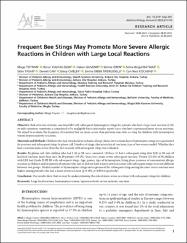| dc.contributor.author | Kocabaş, Can Naci | |
| dc.contributor.author | Toyran, Müge | |
| dc.contributor.author | Çelik, İlknur Kulhas | |
| dc.contributor.author | Güvenir, Hakan | |
| dc.contributor.author | Özen, Selime | |
| dc.date.accessioned | 2023-08-02T06:40:38Z | |
| dc.date.available | 2023-08-02T06:40:38Z | |
| dc.date.issued | 2023 | en_US |
| dc.identifier.issn | 1308-9234 | |
| dc.identifier.uri | https://aai.org.tr/uploads/pdf_471.pdf | |
| dc.identifier.uri | https://hdl.handle.net/20.500.12809/10828 | |
| dc.description.abstract | Objective: Risk of severe systemic reactions(SR) with subsequent hymenoptera stings for patients who had a large local reaction (LLR) or only cutaneous symptoms is considered to be negligible but recent studies report cases who have experienced more severe reactions. We aimed to evaluate the frequency of reactions that are more severe than previous ones after re-sting for children with hymenoptera venom hypersensitivity reactions.Materials and Methods: Children who had attended four pediatric allergy clinics for reactions due to hymenoptera sting were questioned for previous and subsequent stings by phone call. Number of stings, characteristics of reactions, type of bee were recorded. Whether they had a reaction more severe than the first reaction with subsequent stings was evaluated.Results: By phone call, 148 children who had LLR or SR were contacted. Of these 55 had a subsequent sting after LLR or SR and 49 had had reactions more than once. In 29 patients (59.1%), there was a more severe subsequent reaction. Twenty (52.6%) of 38 children with LLR had Grade II-III SR with subsequent stings. Age, gender, type of hymenoptera, living place, presence of concomitant allergic reaction in children and/or parents of patients who had or did not have a more severe reaction with subsequent stings were not different between two groups. Median number of hymenoptera stings and sequence of the subsequent sting causing the most severe reaction were higher among patients who had a more severe reaction (p<0.001, p<0.001 respectively).Conclusion: Our results show that we may be underestimating the risk of more severe reactions with subsequent stings for children. | en_US |
| dc.item-language.iso | eng | en_US |
| dc.publisher | BILIMSEL TIP YAYINEVI | en_US |
| dc.relation.isversionof | 10.21911/aai.041AsthmaAllergyImmunol2023 | en_US |
| dc.item-rights | info:eu-repo/semantics/openAccess | en_US |
| dc.subject | Large local reaction | en_US |
| dc.subject | Hymenoptera venom | en_US |
| dc.subject | Hypersensitivity | en_US |
| dc.subject | Severe systemic reactions | en_US |
| dc.title | Frequent Bee Stings May Promote More Severe Allergic Reactions in Children with Large Local Reactions | en_US |
| dc.item-type | article | en_US |
| dc.contributor.department | MÜ, Tıp Fakültesi, Dahili Tıp Bilimleri Bölümü | en_US |
| dc.contributor.authorID | 0000-0001-8859-7187 | en_US |
| dc.contributor.institutionauthor | Kocabaş, Can Naci | |
| dc.relation.journal | ASTIM ALLERJI IMMUNOLOJI | en_US |
| dc.relation.publicationcategory | Makale - Uluslararası Hakemli Dergi - Kurum Öğretim Elemanı | en_US |


















